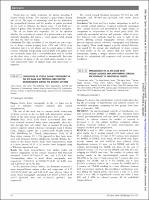| dc.contributor | Vall d'Hebron Barcelona Hospital Campus |
| dc.contributor.author | Otero Areitio, Nausica |
| dc.contributor.author | Martinez-Conesa, Eva Maria |
| dc.contributor.author | Agustí Rovira, Elba |
| dc.contributor.author | Pujagut Mercader, Natzaret |
| dc.contributor.author | Sabater-Cruz, Noelia |
| dc.contributor.author | Fariñas Barbera, Oscar |
| dc.contributor.author | Vilarrodona, Anna |
| dc.date.accessioned | 2023-08-31T11:27:13Z |
| dc.date.available | 2023-08-31T11:27:13Z |
| dc.date.issued | 2023-08-21 |
| dc.identifier.citation | Otero Areitio N, Martinez-Conesa EM, Agustí Rovira E, Pujagut Mercader N, Fariñas Barbera Ó, Sabater-Cruz N, et al. P09-A130 Management of an eye bank with organ-cultured and hypothermic corneas: microbiology in endothelial grafts. BMJ Open Ophthalmol. 2023 Aug 21;8(Suppl 2):A4.2-A5. |
| dc.identifier.issn | 2397-3269 |
| dc.identifier.uri | https://hdl.handle.net/11351/10196 |
| dc.description | Banco de ojos; Injertos endoteliales |
| dc.language.iso | eng |
| dc.publisher | BMJ |
| dc.relation.ispartofseries | BMJ Open Ophthalmology;8(suppl 2) |
| dc.rights | Attribution-NonCommercial 4.0 International |
| dc.rights.uri | http://creativecommons.org/licenses/by-nc/4.0/ |
| dc.source | Scientia |
| dc.subject | Còrnia |
| dc.subject | Trasplantació d'òrgans, teixits, etc. |
| dc.subject | Contaminació |
| dc.subject | Microorganismes |
| dc.subject.mesh | Eye Banks |
| dc.subject.mesh | Drug Contamination |
| dc.subject.mesh | Cornea |
| dc.title | P09-A130 Management of an eye bank with organ-cultured and hypothermic corneas: microbiology in endothelial grafts |
| dc.type | info:eu-repo/semantics/article |
| dc.identifier.doi | 10.1136/bmjophth-2023-EEBA.9 |
| dc.subject.decs | bancos de ojos |
| dc.subject.decs | contaminación de medicamentos |
| dc.subject.decs | córnea |
| dc.relation.publishversion | http://dx.doi.org/10.1136/bmjophth-2023-EEBA.9 |
| dc.type.version | info:eu-repo/semantics/publishedVersion |
| dc.audience | Professionals |
| dc.contributor.organismes | Institut Català de la Salut |
| dc.contributor.authoraffiliation | [Otero Areitio N, Pujagut Mercader N, Vilarrodona Serrat A] Barcelona Tissue Bank, Banc de Sang i Teixits (BST) Barcelona, Spain. Vall d’Hebron Institut de Recerca (VHIR), Barcelona, Spain. [Martinez-Conesa EM, Agustí Rovira E, Fariñas Barbera Ó] Barcelona Tissue Bank, Banc de Sang i Teixits (BST) Barcelona, Spain. Biomedical Research Institute (IIB-Sant Pau; SGR1113), Barcelona, Spain. [Sabater-Cruz N] Hospital Clínic, Barcelona, Spain |
| dc.identifier.pmid | 37604569 |
| dc.rights.accessrights | info:eu-repo/semantics/openAccess |

 Área privada
Área privada Contacto
Contacto







